 Morel mushrooms (morchella), are a Christmas tree shaped edible mushroom that pop up during the spring in North America, Turkey, India, Pakistan, Poland, China, the Himalayas, Australia, and other countries(1). They possess a unique porous and conical shape that helps to make them easily identifiable. Their excellent flavor and unique texture has made the morel mushroom a popular item on high end restaurant menus and has helped the morel to become a multimillion dollar industry. The information on this page will educate you on the different kinds of morel mushrooms, the environments they grow in, when and how to look for them and other morel mushroom hunting tips. To go to the 14 Morel Hunting Tips click here.
Morel mushrooms (morchella), are a Christmas tree shaped edible mushroom that pop up during the spring in North America, Turkey, India, Pakistan, Poland, China, the Himalayas, Australia, and other countries(1). They possess a unique porous and conical shape that helps to make them easily identifiable. Their excellent flavor and unique texture has made the morel mushroom a popular item on high end restaurant menus and has helped the morel to become a multimillion dollar industry. The information on this page will educate you on the different kinds of morel mushrooms, the environments they grow in, when and how to look for them and other morel mushroom hunting tips. To go to the 14 Morel Hunting Tips click here.
The different types of morel mushrooms
Here is a brief description of the main two types of morel mushrooms you can find in the wild. They will be listed in the chronological order in which they appear during the morel mushroom hunting season.
Black morel mushrooms
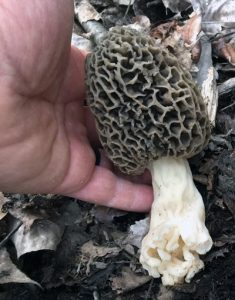 The black morel mushroom, Morchella elata, is normally the first morel to grow during the morel hunting season. This smaller species of morel has black ridges with yellowish pits on its conical cap.
The black morel mushroom, Morchella elata, is normally the first morel to grow during the morel hunting season. This smaller species of morel has black ridges with yellowish pits on its conical cap.
The cap of the black morel can grow upwards of 2 inches high with a width of 1.5 inches. The typical cap plus stalk measurement of a mature black morel mushroom will be between 2.5 to 6 inches.
The black morel mushroom is by far the hardest morel to find due to its smaller size and darker color. If you’re out early in the season and the blacks are up, you’ll find the toughest black morel to find is the first one; these little guys blend in!
Once you find the first one, you can calibrate your eyes for the next couple. Like other morel mushrooms, once you find one black morel, you can normally find a couple more. Work slow and scan hard.
Yellow morel mushrooms
The yellow morel mushroom, Morchella esculenta, is the larger of the morel mushroom species. Yellow morels typically grow in the last half of the morel season and are much easier to find due to their size. The size range of the yellow morel is anywhere from a couple inches tall to over 12 inches. The width of the yellow morel mushrooms can be anywhere between an inch to 3 inches or more.
Due to their size and color, yellow morel mushrooms are the most commonly picked. They often can be spotted from a good distance and where there is one yellow there is normally more.

Beware of the false morel mushroom
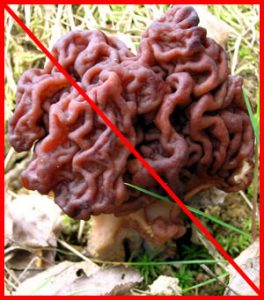 The main mushroom to watch out for is the false morel. The false morel will grow in morel rich areas. To the experienced morel hunter, they are easily identified from a distance due to their different shape and color. Its shape is very irregular compared to a morel and it’s color is reddish brown.
The main mushroom to watch out for is the false morel. The false morel will grow in morel rich areas. To the experienced morel hunter, they are easily identified from a distance due to their different shape and color. Its shape is very irregular compared to a morel and it’s color is reddish brown.
The poison in the false morel is monomethylhydrazine or MMH. It’s a cumulative poison that stays in your system. If eaten, they can be very hazardous to your health.(3)
If you are new to morel hunting, carry a picture of this reddish mushroom with you to ensure you don’t mistake it for a morel. It is always a great idea to have an experienced mushroom hunter verify any mushroom that you pick prior to consumption.
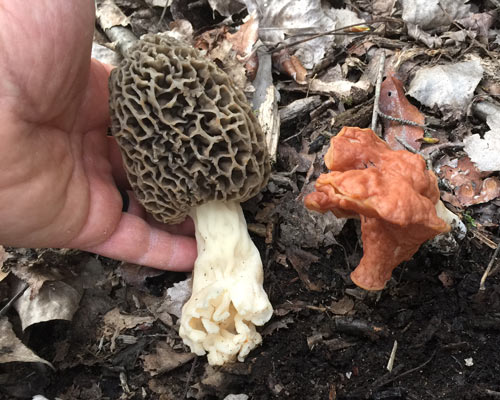
What conditions are need for morels to grow?
Morel mushrooms need a combination of conditions for optimal growth. In some years the required conditions happen at the same time resulting in a great harvest while in other years, you may only find a couple. Let’s look at what needs to happen for morel mushrooms to grow.
The right soil conditions
The ideal soil for typical morel growth is a soft moist soil. This soil can be a sandy soil or a spongy damp soil often found in fairly dense wooded areas. If the ground is too hard or dry, the spores and their mycelium can’t penetrate the soil and the mushrooms won’t grow. Look for areas that receive plenty of sun but have enough undergrowth to allow the needed moisture retention. Moderate rainfall is a welcome sign come morel season. Moist ground is good ground.
The right temperatures
The ground temperature has to be just right for morels to grow. Reports on the perfect soil temperatures will vary, but a good rule of thumb is 60 degrees for 3 days. To be more exact, the ground temperature 4 inches down should be at least 55 degrees for growth to start. The growth will stop once the surface temperature reaches 62 or more degrees.(2) Typically, when lilac bushes and mayflowers are in bloom, it’s pretty close to morel picking time! In the midwest, late April and early May should be the time to hit the woods.
The right food source
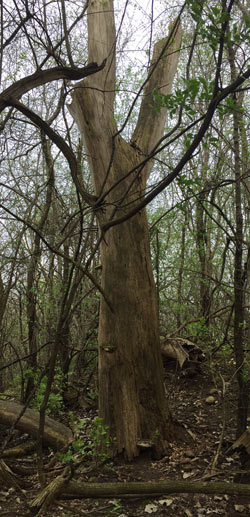
Without getting too crazy into the science of morel growth, we will point out which dying or decaying trees generally produce morel mushrooms. There trees are elm, apple, cottonwood, ash, and sycamore trees.
The most notorious of the list is the elm tree. Due to dutch elm disease, many elm trees are at the perfect stage of the dying process to produce what is needed for morel growth. Elm trees can easily be identified by the early split or “Y” of it’s trunk. Look for elm trees that are no longer producing leaves and have deteriorating bark. The elm tree pictured is what you want to look for. Ideally, it would be in the earlier stages of dying but it presents a great place to look regardless.
Although certain trees seem to produce a higher number of morel mushrooms, morels can grow anywhere. Sometimes what is needed for morel growth may have been deposited into the soil years ago and will continue to produce mushrooms year after year.
14 Morel mushroom hunting tips
Morels can be a very elusive mushroom to find, but if you know what kinds of environments to look for, you’ll drastically increase your odds. Here are some of our favorite places for morel mushroom hunting.
1. Look for morels in hilly areas
Hilly areas are my favorite place to look for morels. Look for small clusters of hills that are around 5 to 15 feet high that have dying trees present as well as enough undergrowth or canopy cover for moisture retention. Check the sun catching southern face of these hills as they typically produce more morel mushrooms.
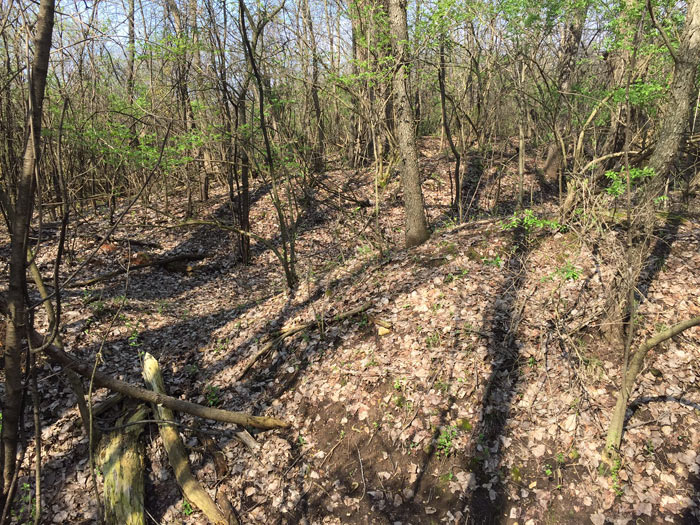
I think hill clusters or sloping hillsides produce consistently because if they catch enough sun and reach the right soil temperature, at some elevation of the hill, the moisture content will be perfect. In some years, the soil’s moisture content will be perfect near the top of the hill while in other years, it will be midway down or at the bottom. I think it’s safe to say that in drier years, we have had better luck near the bottom of the hills and in wetter years we have found more morel mushrooms near or at the top of the hills.
When you deal with hills, you also have water drainage that can carry morel producing goodness down the hill from a dying tree. This is why sometimes you’ll find morels on the downward hillside adjacent to a producing tree.
2. Hunt morels in rocky areas
Look for morels in and around rocky areas. Just like undergrowth, rocks block the sun and keeps the soil from drying up. Rocks also absorb heat very well providing the much heat which is the second crucial piece to the puzzle. If you get into a moderately rocky area, take your time and look between these morel producers.
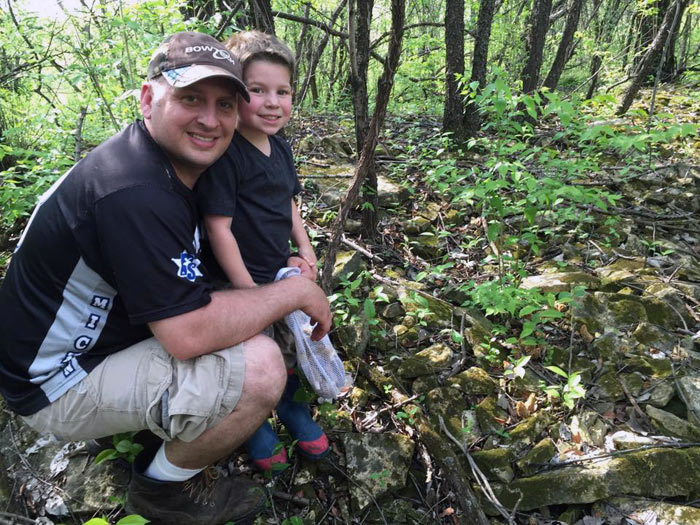
3. Search flat areas rich with deadfall and moderate undergrowth
Undergrowth and deadfall are a great combination because they both help to keep mushroom producing soil moist. If the deadfall is from one of the morel producing trees and the soil is moist and at temperature, you may be in luck. Scan these areas slowly and if you find a morel, put on the brakes and scan carefully because there are probably more right under your nose waiting to be found.
4. Use a walking stick
A walking stick will help you in many ways. They can help you maneuver tough terrain, help you push undergrowth to the side when looking for mushrooms, and they can help you identify great morel producing soil.
For my walking stick, I use an old wooden hockey stick that has the blade cut off. Wooden hockey stick shafts are lightweight and strong making them ideal to carry while looking for morels. To test the soil with my walking stick, I usually see how hard it is to push it a couple inches down into the soil. If it penetrates without a problem, I know the soil is at the ideal compaction.
5. Hunt for morels in areas with disturbed soil
Search for morels in old spoil piles of soil near strip mine lakes. Something about these spoil hills produces tons of morels year after year. All the factors such as moisture, temperature, and decaying timber has to be just right, but when they are, you will probably be filling your bag full of morels in no time.
6. Look around lightning strike areas for morels
Do you know of a tree in the woods that was struck by lightning? Go there and look hard. Lightning struck morel producing trees can be a gold mine if the temperature and moisture levels are just right.
7. Angle your viewing to be parallel to hill slopes
When working hillsides, get your line of sight to scan 1 to 2 feet above the hillside and parallel. Picture yourself at the top of the hill and looking down to where it’s like you’re scanning the top of a table. Morels may becoming more visible.
If you’ve ever torn off a roof before, this is like getting on the other side of the ridge and checking along the surface of the roof for nails that are sticking up. Another comparison is like if you drop something on he floor and can’t find it so you get your eyes close to the floor so the object stands out. I hope this made sense!
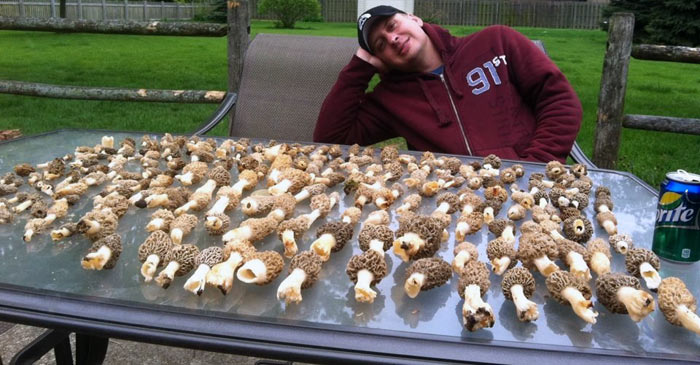
8. Use a GPS unit to track your finds
Don’t rely on your memory of where your best finds were, use a GPS! With our busy lives, our memories can become foggy over time but a GPS will never forget. It is absolutely amazing how the same section of woods can look completely different after a couple of years. Even if you had a great memory and an internal compass, it would still be a huge challenge to consistently locate hotspots year after year.
9. Cut or pinch the stalk of every morel mushroom you pick
When you find a morel, use scissors, a knife or your pinching fingers to cut the morel from its roots. You would eventually cut the roots off while cleaning your mushrooms so you should leave it in the ground to help grow mushrooms in future years.
10. Only use mesh bags for transporting morel mushrooms
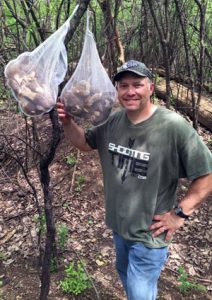
Mesh bags are essential if you want to see morels year after year in your morel hunting spots. The mesh of the bag allows the spores of your picked morels to drop to the ground which helps to seed future morels. The mesh bags will also allow dirt and bugs to shake to the ground while you’re tramping through the woods.
The bags in the adjacent image can be purchased at most stores for only a couple of dollars. Look for mesh laundry bags. Just say no to the plastic grocery bag!
11. Work the elevations where you’ve had success
If you are working small or large hillsides, you should focus on the elevation where you are seeing mushrooms. I believe this is because the moisture content is ideal at that point of the hill. Work the elevation laterally until your luck runs out. This morel hunting tip will put a few more in your bag this season.
12. Check message boards to track successful morel mushroom hunts
Morels findings will start in the south and move north. I would say that morel sightings travel about 100 miles in a week. If you keep an eye on morel hunting message boards and forums, you’ll be able to figure out exactly when you should be checking your morel hot spot.
13. Wear tick repellant
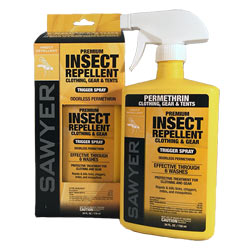 The last thing you want to be doing is constantly looking for ticks. We have all been there; every 30 minutes, feeling like something is crawling up your calf. You obsessively check yourself and bat an imaginary tick off you often like a crack addict. Spray yourself down and you won’t have to worry.
The last thing you want to be doing is constantly looking for ticks. We have all been there; every 30 minutes, feeling like something is crawling up your calf. You obsessively check yourself and bat an imaginary tick off you often like a crack addict. Spray yourself down and you won’t have to worry.
Our favorite go to tick spray is called Sawyer Insect Repellent. All you do is spray down your mushroom picking clothes, let it dry and you’re set for quite awhile. It’s odor free also so it can be used later in the year during hunting season. Don’t focus on ticks, focus on mushrooms.
14. Mums the word
As the old saying goes, 3 people can keep a secret if 2 of them are dead. Same goes for good mushroom spots. Choose very carefully who you bring on your mushroom hunting adventures. If the person cannot be trusted, you may find out that they hit the spot that you showed them, next year or 5 years down the road. Sometimes less is more when it comes to mushroom hunting parties!
Summary on Morel Mushroom Hunting
Becoming a great morel hunter takes time. As the years go by, you’ll continue to become more and more successful when hunting these spring delicacies. Who knows, if you log enough hours in the woods, you may be able to develop that sixth sense that will fill your mesh bag full of morels! Good luck.
Resources
- https://en.wikipedia.org/wiki/Morchella
- http://www.naturealmanac.com/archive/morels/morels.html
- http://www.michiganmorels.com/morels2.shtml
